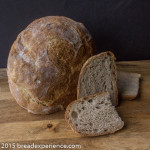Description
This Dutch Oven Emmer Bread, made with an overnight poolish, and baked in a ceramic Dutch Oven, has a delicious, and slightly nutty flavor. The Dutch Oven provides the perfect environment for making a big round loaf of crusty bread.
Ingredients
Overnight Poolish:
- 375 grams (50%) white bread flour
- 375 grams (50%) water, 80 degrees F.
- scant 1/8 teaspoon instant yeast
Final Dough:
- 187.5 grams (25%) whole grain Emmer (I used home-milled flour)
- 187.5 grams (25%) white bread flour
- 263 grams (70%) water
- 12 grams sea salt
- 1/2 teaspoon instant yeast
- 2 teaspoons ground flax seed
Instructions
Prepare the Poolish:
Mix the poolish ingredients in a large container or bowl. Cover and let the mixture rest overnight for 12 –14 hours at room temperature. When the poolish is fully ripe, it will be bubbly and ready to be used in the final dough.
Mix the Final Dough
The next day, mix the flours and yeast in a separate large bowl. Pour the water over the poolish and loosen it from the sides of the container or bowl using a spatula or bowl scraper.
Pour the water/poolish mixture over the flour mixture and using wet hands, mix the dough until there are no dry bits of flour. Mixing the dough using the fold-and-turn method in the bowl makes things easy and keeps the work surface cleaner.
Cover the bowl and let the dough rest for 10 to 15 minutes. Sprinkle the salt over the top of the dough and work it in thoroughly using your fingers.
Bulk Ferment: 2 – 3 hours
Scrape down the bowl using a plastic dough scraper or a spatula, then cover the bowl with a kitchen towel or plastic wrap and allow the dough to bulk ferment for 2 to 3 hours. During the bulk fermentation, perform 3 folds every 20 minutes for the first hour, then let the dough rest for the final 2 hours. The dough should be about 2 1/2 times its original size when it’s ready to be mixed.
Final Proof in Banneton Basket – 1 hour
Dust the work surface and your hands. Transfer the dough to the floured work surface and shape the dough into a rough boule. Let it rest for 15 to 20 minutes. Then shape it into a medium-tight ball and place it seam side down in a floured banneton basket.
Lightly flour the top of the loaf and cover it with a kitchen towel or plastic wrap. Let the loaf proof for an hour in the proofing basket. To determine when the loaf is fully proofed, do the finger-dent test. If the indention returns slowly, it is ready.
Preheat the oven and Dutch oven – at least 45 minutes
At least 45 minutes before baking, preheat the oven to 475 degrees F. with a Dutch oven (with the lid on) on the bottom rack.
Bake the Loaf
When you are ready to bake the bread, gently ease the loaf out of the proofing basket onto a piece of parchment paper.
Score the loaf using a lame or serrated knife.
Using a heavy-duty oven mitt, remove the Dutch oven to a towel or pad, carefully lift the parchment paper (with the loaf on it), and place it in the bottom of the Dutch oven. Place the Dutch oven in the preheated oven (using heavy mitts) and then place the lid on top.
Let the loaf bake covered for about 30 minutes at 475 degrees F. Then uncover it, turn the oven temperature down to 450 degrees F., and let it bake an additional 20 to 30 minutes.
Remove the Dutch oven to a heavy towel or pad and carefully tilt the bread out. Let the loaf cool on a wire rack for at least 30 minutes before slicing.
Notes
Transferring the risen loaf from the proofing basket to the preheated and very hot Dutch oven can be tricky so I like to utilize a ‘parchment sling’ to reduce the chances of getting burned.
You can also sprinkle cornmeal on the bottom of the baker or cut a circle of parchment paper to fit the bottom, but it’s quite easy using the parchment sling.
- Category: Artisan Boule
- Method: Poolish
